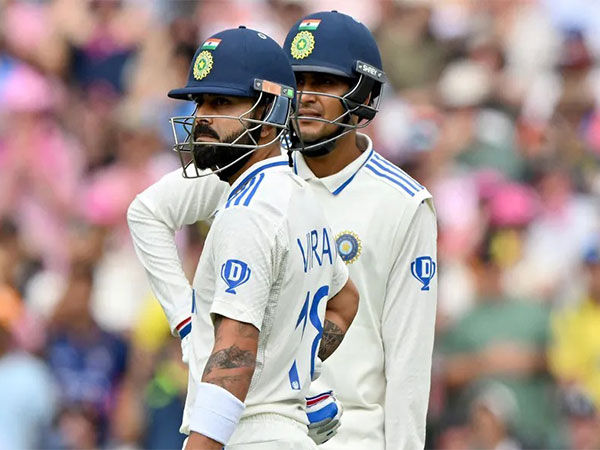
Sydney [Australia], January 5: Former Indian cricketer Sunil Gavaskar stated that ahead of the next ICC World Test Championship (WTC) cycle, the head coach must ensure that players play more domestic cricket and make tough decisions against those who choose not to play due to poor batting performances during the home series against New Zealand and the Border-Gavaskar Trophy in Australia, which cost India the hat-trick of WTC final appearances.
Virat Kohli (190 runs in five matches and nine innings at an average of 23.75 with a century) and captain Rohit Sharma (31 runs in three matches and five innings at an average of 6.20) were particularly criticized by Gavaskar for their technical shortcomings with the bat during the BGT. Throughout the series, Virat was dismissed four times by bowler Scott Boland after falling for the outside-off-stump trap.
Regarding India’s batting performances, the renowned cricketer said on Star Sports, “What I saw were technical deficiencies.” What did you do against New Zealand in India if you have been making the same mistakes—and I’m not only referring to this series, I’m also talking about the New Zealand series. And that’s why we haven’t qualified for the World Test Championship yet, since the next cycle begins in June. We should be prepared for it from now on. We shall be forced to make difficult choices if they are necessary.
“Today is January 5,” he said, encouraging players to participate in the next round of Ranji Trophy matches. The next Ranji Trophy round is scheduled on January 23. See how many of this team’s players show up. Let’s check the number of persons available. Furthermore, there ought to be no justification for not being allowed to play. Gautam Gambhir would have to make some difficult choices against players who are unavailable for the Ranji Trophy if you don’t play those games, in my opinion. He will have to say, “You do not have that commitment.” We need dedication. You’re not having fun. Do whatever it is you want to do. However, you are not allowed to rejoin the Test team for Indian cricket.
Gavaskar also discussed the Indian batting lineup’s dearth of hundreds, pointing out that only Nitish Kumar Reddy and Yashasvi Jaiswal had each scored one. He said that the Indian batting lineup’s “application and determination” were really poor.
How many hundred-point scores have been made by Indian players? Nitish Kumar Reddy’s century is the only one apart from the inaugural Test match, which had two hundreds. What percentage of players achieved half-centuries? You may argue that hitting a century is difficult, but how many players attempted to change the outcome with half-centuries? It didn’t happen because there wasn’t enough application or desire, which is necessary in Test cricket,” he remarked.
It has been a terrible Test season for ‘Ro-Ko’ (Rohit and Kohli) thus far in 2024-25. Virat amassed an absurd 382 runs in 10 games and 19 innings at an average of 22.87, with just a century and fifty apiece, whereas Rohit only managed 164 runs in eight games and 15 innings at an average of 10.93 with a top score of 52.
India chose to bat first in the SCG Test after winning the toss. As the top order threw away their wickets, particularly Virat Kohli (17), who continued to struggle with outside off-stump deliveries, India got off to another dismal start.
But India reached 185/10 in 72.2 overs thanks to the efforts of captain Jasprit Bumrah (22 in 17 balls, with three fours and a six), Rishabh Pant (40 in 98 balls, with three fours and a six), and Ravindra Jadeja (26 in 95 balls, with three fours).
The Australians’ best bowler, Scott Boland (4/31) was once again a source of frustration for Indian hitters. Pat Cummins received 2/37 and Mitchell Starc grabbed 3/49.
Australia lost wickets often in their first innings, even after Jasprit Bumrah (2/33) left the field because of a serious injury scare. India continued to dominate the Australians under the interim captain Virat, dismissing them for only 181 runs and gaining a four-run lead. Steve Smith (33 in 57 balls, with four boundaries and a six) had some attacking intent, while debutant Beau Webster (57 in 105 balls, with five fours) produced a strong batting performance.
The two best bowlers for India were Mohammed Siraj (3/51) and Prasidh Krishna (3/42).
Yashasvi Jaiswal (22 in 35 balls, four boundaries) and KL Rahul (13) put up a 45-run partnership to give India a four-run lead and a promising start. However, Boland (6/45) once again caused problems for the Indian batsmen. With 61 runs in 33 balls (six fours and four sixes), Pant did mount a counterattack, but India was bowled out for 157 runs, giving the Australians a 162-run victory. During the last innings, Bumrah was unable to bowl.
Australia struggled for a while during the chase of 162 runs at 58/3, but despite a fight from Prasidh Krishna (3/65), the team won by six wickets thanks to the knocks of Usman Khawaja (41 in 45 balls, with four boundaries), Travis Head (34* in 38 balls, with four boundaries), and Webster (39* in 34 balls, with six fours).
Bumrah won “Player of the Series” with 32 wickets, while Boland won “Player of the Match” with his ten-wicket haul.